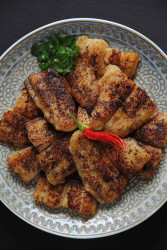Hi Everyone,
We like bun-bun but not burnt food. Blackened dishes can often end up looking burnt but they aren’t. Blackening is a cooking technique that yields significant char on the surface of food that at first glance can seem burnt. The spice combination and billowing smoke give the food an intense, desirable flavour.

The cloud of smoke comes from the blackening process. Here is how it all works. The ingredient (for ease of reference, let’s use fish) is dipped in melted butter and then dredged in a blackening spice mix. The fish is then added to a smoking hot, dry, cast iron pan. When the fish makes contact with the hot pan, the spices from the seasoning and the curds from the melted butter start to brown and char giving off plumes of smoke that rise up and fill the air. That’s cooking blackened baby!
You’re not intimidated right? Of course you aren’t so let’s continue.

I’ve already indicated that quick-cooking ingredients are best for this technique; fish is the first ingredient that was used to make this and it is still the most popular ingredient to cook blackened. You can use any type of fish, skin on or off, filleted or bone-in, whole or steak-cut.
While the seasoning blend is something you can make at home, this is one occasion in which I would suggest using store-bought because the right proportion of ingredients have to be mixed together so that the flavour is guaranteed and that you don’t end up putting too much of one ingredient that might burn and give off a bitter taste. There are several brands to choose from, I suggest that you try different ones to determine which one you like best. For example, I bought a blend from a well-known spice provider in the region, it’s nice but I prefer the taste I got from a smaller packet I picked up in another supermarket that is made by a local manufacturer. Taste, as you know, is subjective, so choose a brand/blend that you like. What I have found is that some blends blacken/char more than others and that is dependent on the ratio make up of the spice blend.
The basic ingredients are ground cayenne or chili powder, paprika, black pepper, onion and garlic powders, dried thyme and dried oregano. Some blends contain salt and some don’t.
A word of caution – do not ever use fresh herbs for this cooking application because they would ruin the dish by quickly burning and becoming bitter.
Seasoning
Blackening is done with butter; there is no getting away from that fact. The butter is key because in addition to providing flavour, the butterfat is needed to assist with the process of blackening.
Once the fish (or whatever ingredient you are using) is rinsed and pat dry. It is seasoned with melted butter and the spice blend. There are two ways to apply the melted butter and seasoning blend. I’ve tried both ways and nothing changes the flavour. The melted butter and spice blend are mixed together and then the fish is dipped into the mixture and added to the pan. Or, the fish can be brushed (on both sides) with the melted butter or be dipped into the melted butter and then generously dusted or liberally sprinkled with the dry spice mix before being added to the pan.
The pan
The best type of pan to use for this dish is cast iron, even if it is coated with enamel. If you don’t have a cast iron pan then use any heavy bottomed pan you have. Do not use a non-stick pan; it will never get as hot as is needed to sear and cook the food and it would not yield the char required for the blackening.
Cooking
The cooking time will vary depending on the size of your burner, the size of your pan (and how many pieces you have added at a time). The time will also depend on what protein you are cooking, the size and thickness. Here is a guide you can use. Remember, this is only a guide, cook using your own instincts and know-how.
- Fish fillets – 1 ½ minutes on each side
- Bone-in fish steaks – 2 ½ minutes on each side
- Large Shrimp – 1 minute on each side
- Skinless-boneless chicken breast – 3 to 4 minutes on each side
- Some fish cook up faster than others so take that into consideration when cooking.
- Bone-in ingredients always need more time to cook than boneless.
- Place the chicken breasts between plastic wrap and pound gently to ensure that the thickness is uniform, as this will ensure even cooking.
Blackening is one of those cooking techniques that demands you discipline yourself not to touch the food for a period of time and not to flip it back and forth. You only need to turn it once. The ingredients will ‘tell’ you when it is ready to be flipped. You determine this when can easily slide a spatula beneath the ingredient. If you put your spatula to the food and get resistance then it is not cooked enough and ready to be flipped.
To blacken any of the vegetables mentioned, it would be best to mix the melted butter and spices together, cut the vegetables into thick slices and brush them with the mixture. Cook the veggies in a very hot grill pan or an outdoor grill.
Last week it was all about staying cool, are you ready to face the fire and smoke this week?
Cynthia
Blackened Fish
SPECIAL EQUIPMENT
Cast iron skillet or heavy-bottomed pan
DIRECTIONS
5 whole fish fillets
½ cup melted butter (unsalted or salted)
¼ cup blackened spice mix (more depending on the size of fillets)
Salt (see notes below)
DIRECTIONS
Cut fillets in half if they are too large to lie flat in the pan, if not leave them whole. Rinse and pat dry with paper towels.
Heat pan over high heat until smoking hot.
Working in batches, generously brush fillets on both sides with melted butter and generously sprinkle with spice mix. Add 1 or 2 fillet at a time (do not overcrowd) to the pan. Cook for 1 ½ minutes on one side or until it is easy to lift. Flip and cook on the other side for another 1 ½ minutes. Remove from pan and repeat until all the fish are cooked.
NOTES
When adding the fish to the pan, place it down on the side that you plan to serve, in this case, the meatier side.
Read the ingredients for the spice mix to ascertain whether or not it contains salt. If it does contain salt, you should not need to add more to season the fish, however, if it does not have salt, add salt to taste to the spice mix.
You may need more melted butter depending on the size of the fish fillets.
Any remaining butter can be drizzled over the fish as it cooks.





